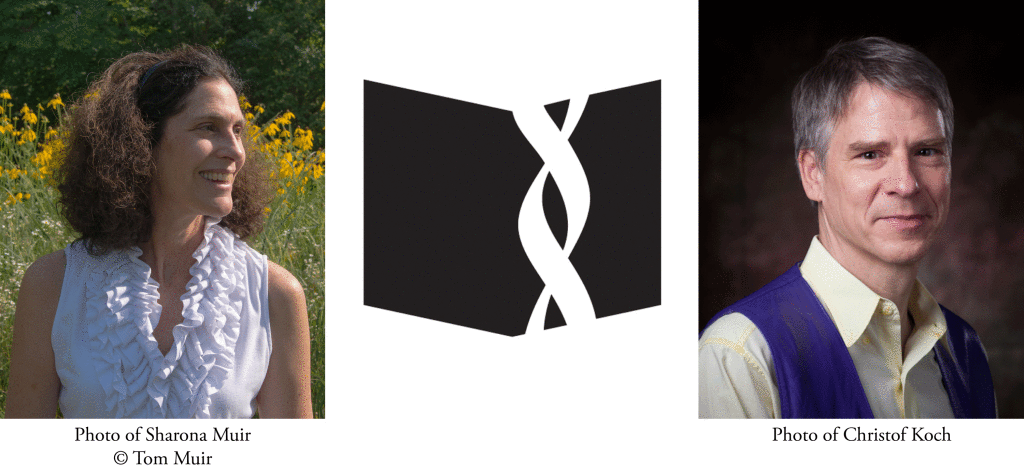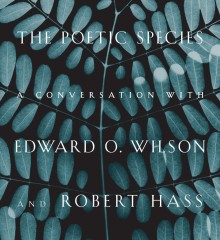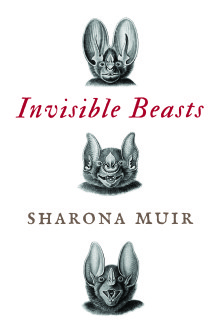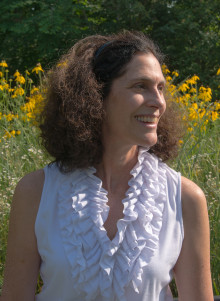Welcome to the BLP Conversations series, featuring dialogues between people whose lifework, like BLP’s mission, explores the creative territory at the intersection of the arts and sciences, and has become a testament to how science and the humanities can join forces to educate and inspire. This online series is inspired by E.O. Wilson and Robert Hass, whose talk about the connections between science and the arts was published in our book The Poetic Species: A Conversation with Edward O. Wilson and Robert Hass.

In this conversation, Sharona Muir, author of the highly acclaimed debut novel Invisible Beasts, speaks to Christof Koch, Chief Scientific Officer of the Allen Institute for Brain Science and author of numerous books, about our scientific understanding of consciousness and subjectivity in relation to art and culture. As their thinking pushes beyond the realm of modern humans, they relate these topics to prehistoric man and the animal kingdom.
Sharona Muir: Marcus Feldman, a Stanford geneticist, claims that you can’t draw a line between human history and evolution. We’ve affected our environment by changing the niches of the biological world. Among humans, the transmission of cultural practices affects gene linkages; for instance, our African ancestors lacked the ability to digest milk, but it appeared later as cultural practice plus selection spread the mutation. Other examples include the cultural power of human authorities to shape populations, or cultural attitudes toward contraception.
Do you see any important parallels to Feldman’s claim in the relationship between culture and the brain (and/or consciousness), especially in modern humans?
Christof Koch: We know almost nothing about the genetic basis of human culture. But we do know from evolutionary theory and from ample observation that the members of any species of animals that are reproductively isolated for sufficiently long—typically by geographic barriers like an ocean or high mountain chain—will develop their own unique genotype/phenotype; i.e. Darwin’s finches on the different islands of Galapagos. We know of a few genetic traits that have arisen in historic times such as lactose tolerance, blue eyes (in Nordic populations), some immune functions and high-altitude adaptation in Tibetans. Those were identified because they are single genes; there are likely to be many more, probably much more complex, that reside in combinations of genes but that will take us very long to uncover. And those might relate to cultural traits.
SM: I’m fascinated by the carved ocher stone discovered at the Blombos site in South Africa. The stone has been taken as evidence for the use of conventional designs in the Middle Stone Age. It bears a design of equal-sized diamonds bisected, and bordered on right and left by straight lines paralleling the limits of the stone. After reading your work, I’m tempted, anachronistically, to see in it a portrait of conscious thought: a complex, interconnected, and irreducible design (with a suggestion of bodily bilateral symmetry). It’s intriguing that other members of genus Homo, besides us, painted with ocher pigment.
Would it be either correct or interesting to say that art-making, or at least ornamentation, is part of our repertoire of biological behaviors, “hardwired” into the brain? Could you comment on the neurological basis of art-making? Why are we addicted to setting ourselves these kinds of aesthetic problems to solve—problems of design, craft, composition, expression?
And is there any scientific basis for supposing aesthetic experience among nonhumans? Could a fox derive aesthetic pleasure from her nicely dug den under my barn? (I’ve written about songbirds and Bowerbirds, and wonder about spiders.)
CK: We find evolutionary and behavioral precursors of all human sensibilities in non-human animals, so I don’t find it difficult to imagine that the aesthetic impulse has likewise precursors in the animal mind. Indeed, primatologists who track great apes in the wild have reported, on occasion after a heavy downpour, when the humidity has cleared, a single ape, staring off into the distance, toward the setting sun, for several minutes. It seems to the human observer that the ape is trying to fathom something, and was caught by the beauty of the setting. Of course, we don’t know what it was thinking. Perhaps not too dissimilar to what a six- or seven-year-old human child might think when confronted with something beautiful.
SM: I’d like to hear anything you felt worth saying about your relationship with laboratory animals. This question is not a PETA-style provocation—you’ve written with conscientious ethics and affection about domestic and lab animals—but I’m curious to hear more about it, anecdotes that come to mind.
CK: I grew up in a devout Roman Catholic family with Purzel, a fearless and high-energy dachshund. Purzel showed plenty of affection, curiosity, playfulness, aggression, shame, and anxiety. Yet my church (the Catholic Church at the time) teaches that dogs don’t have souls. Only humans do. Even as a child, I felt intuitively that this was wrong. These gorgeous creatures had conscious feelings, just like I did. Why would God resurrect people but not dogs? This didn’t make any sense to me. Either we all have souls or none of us do.
The first time my black German shepherd, Nosy, encountered snow, high up in the Rocky Mountains, she stuck her snout into the curious white stuff, threw some of it into the air, and caught it again. She bit into its icy crust, she barked at the snow bank, and finally she threw herself on her back and slithered back and forth, rubbing the cold crystals into her fur. She was a living manifestation of joy! Nosy became depressed for a couple of weeks when a puppy joined our household and life revolved around the new family member: excited when retrieving a tennis ball; aggressive when another dog challenged her; ashamed, with her tail tucked between her legs, when she committed some no-no; fearful and in need of Prozac during fireworks; bored when I worked all day and neglected her; alert as soon as a car entered the driveway; annoyed when she was waiting for food to drop during cooking and one of the kids poked her; and curious when we returned from grocery shopping, sticking her snout into every bag to inspect its contents.
The night Nosy lay dying in my arms, I was distraught. While I was holding a wake for her, I was wondering how I could be so affected while I loved to eat the flesh of animals whose brains were not that much simpler that her brain (cows, pigs, and lambs). To honor her life, I resolved that night, about a decade ago, to never again eat the flesh of mammals or birds.
My final conversion on the road to Damascus came from a horrid YouTube video in which people at a Chinese restaurant were poking with their sticks at a partially cooked fish that was obviously still alive. While the guests were laughing, the agony in the eyes of the suffering creature evoked an almost overwhelming feeling of pity for its distress.
So now I’m a vegetarian.
SM: Reading Consciousness: Confessions of a Romantic Reductionist was exciting. How liberating it is to read a rigorous theory that gives bodily experience and knowledge (as in rock climbing, dancing, etc.) as much validity as language. The way you’ve put self-awareness in proportion is also quite refreshing. While I’m unqualified to discuss the axioms and postulates in “Here, There, But Not Everywhere,” your ideal and empirical tools for mapping our double reality seem elegantly powerful, as is the premise that consciousness and living matter go hand in hand. Two ideas strike me as poetic. First, that experience is shaped as much by possibility (silent neurons) as by actuality (messaging neurons). Second, the idea of qualia spaces; how charming to call them “crystals,” as if conscious experiences were a continuous snowfall through the universe!
CK: The quality/quale of any one experience—the way in which red feels different from blue and a color is different from a tone or a pain—is conveyed by the informational geometry associated with phi, that is, with integrated information. The theory assigns to any brain state a shape in a fantastically high-dimensional qualia space. This shape, this crystal you refer to, is the system viewed from within. It is the voice in your head, the light inside your skull. It is everything you will ever know about the world. It is your only reality. It is the quiddity of experience. The dream of the lotus eater, the mindfulness of the meditating monk, the agony of the cancer patient, and the aesthetic feeling induced by a Rothko painting all feel the way they do because of the distinct shapes in an informational space of a trillion dimensions. Truly a beatific vision.
SM: Consciousness is fascinating not only for its subject matter, but also for the “subjective” component, the memoir aspect of the work. It seems to me that for a scientist to venture into memoir requires courage. Would you care to talk a little about what it’s like for a scientist to write personal accounts in a book about his own work?
CK: I’ve gotten two classes of responses to this mixing of the personal, autobiographical with the objective, scientific. A few readers, including editors, find this mixing inappropriate, while it resonates deeply with others who tell me stories of a similar religious upbringing and loss of belief. I try to make the larger point—made already by Karl Marx and Sigmund Freud—that our work shapes who we are and that what we choose to work on is often based on childhood experiences, desires, and dreams. So I want to understand the poetry of the world in a scientific and mathematical manner before I die—in particular this most mysterious of all phenomena: subjectivity.
SM: Are there unanswered questions that you see as major priorities in the field of neuroscience and consciousness—any burning questions in your own work that are particularly consuming right now?
CK: Open questions. There is a large discrepancy between the experienced richness of phenomenal experience. That is, any one conscious experience—me looking around my living room—is replete with color, textures, motion, sounds, locations, memories, meanings—yet if people are queried under quantitative conditions in a laboratory, only a few dregs of bits can be recovered. Thus, many philosophers and psychologists have argued that the perceptual richness is an illusion and that at any given point in time we only have conscious access to little information, akin to what is in working memory (at most seven chunks of information). How can we reconcile the apparent opulent world of conscious subjective experience and the poverty of reports?
Sharona Muir is the author of The Book of Telling: Tracing the Secrets of My Father’s Lives, a collection of poetry, a collection of literary criticism, and the novel Invisible Beasts.. Her writing has appeared in Granta, Orion magazine, Virginia Quarterly Review, The Paris Review, Kenyon Review, and elsewhere. She is the recipient of a National Endowment for the Arts Fellowship, the Alfred Hodder Fellowship from Princeton University; two Ohio Arts Council Fellowships; the Memorial Foundation for Jewish Culture Fellowship; the Bernard F. Connors Prize, and other awards. She is currently a professor of Creative Writing and English at Bowling Green State University.
Christof Koch researches the biophysics of nerve cells, and the neuronal and computational basis of visual perception, attention, and consciousness. In 2011, he became the Chief Scientific Officer at the Allen Institute for Brain Science in Seattle, where he leads a ten-year, large-scale, high-throughput effort to build brain observatories to map, analyze and understand the cerebral cortex.
He has authored more than 300 scientific papers and articles, eight patents, and five books. Together with his longtime collaborator, Francis Crick, Christof pioneered the scientific study of consciousness. His latest book, Consciousness: Confessions of a Romantic Reductionist, deals with the philosophical, religious, scientific, technological, and personal questions relating to his research.




